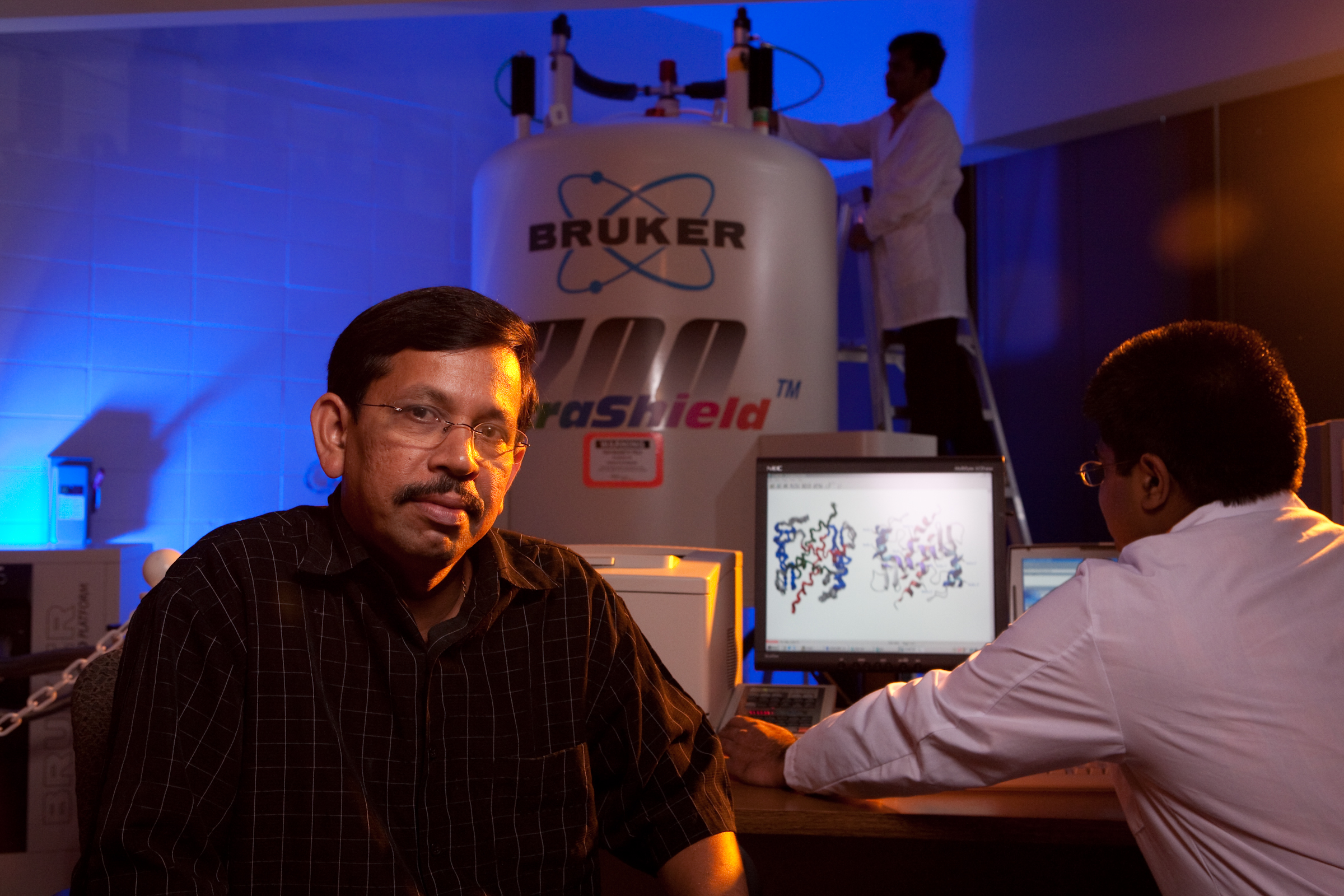Researchers Examine Ways to Combat Flu Virus

Suresh Kumar, associate professor of chemistry and biochemistry, and his colleagues will explore the interactions of two essential proteins involved in infection with the influenza virus in hopes of creating more effective vaccines and treatments for the disease.
FAYETTEVILLE, Ark. – Four University of Arkansas researchers will look at ways to prevent and treat the influenza virus thanks to a grant from the National Institutes of Health.
The researchers will receive $854,803 over two years as part of the American Recovery and Reinvestment Act of 2009 to study novel ways to prevent and treat the influenza virus, which kills about 36,000 people each year and sends another 200,000 to the hospital.
Despite the development of four FDA-approved antiviral medications, only two remain effective, because of viral mutations. Proteins on the outside of the virus shell – the “H” or hemagglutinin and “N” or neuraminidase proteins – change their shape rapidly and render vaccines ineffective. These protein mutations even allow the virus to slip by a previously infected immune system and subject the victim to fever, chills and aches. Therefore, people continue to flock each fall to get a new flu shot.
“The virus is ‘smart’ in that it modifies proteins on the outside so that the hosts’ body cannot recognize it,” said Suresh Kumar, assistant professor of chemistry and biochemistry. This is why vaccines for the flu must be updated annually. “We need to be one step smarter than the virus and attack something it is not anticipating.”
To this end, Kumar and his colleagues Yu-Chun Du, Robyn Goforth and Ralph Henry in biological sciences will study a different viral protein called NS1.
“NS1 facilitates the virus to hijack the host cell machinery to make its own proteins,” Kumar said. It also blocks the cells’ natural defenses in the form of a group of proteins called interferons.
Because NS1 must interact with host cells, it changes little over time, making it a prime target for researchers who hope to shut down the flu. However, to create a novel vaccine or treatment based on this protein, scientists must understand how NS1 goes about its hijacking.
“The aim of this grant is to identify novel host proteins that interact with NS1,” Kumar said. So Du will use a mass spectrometry technique developed in his laboratory to identify key interactions between NS1 and host cell proteins, where chemical bonds have formed. Then Kumar will use nuclear magnetic resonance spectroscopy to identify the specific chemical interactions between NS1 and the host proteins to find out how NS1 recognizes the correct host proteins to bond with.
“Knowing this, we could then identify ways to interfere with the interactions,” Kumar said.
The second part of the project will focus on interferon, a group of proteins essential to the body’s natural defense system. Interferon is often suppressed by NS1 during the initial attack of the virus. The researchers, working with scientists at the University of Arkansas for Medical Sciences, have found mutant forms of interferon with strong antiviral and antitumor activity. But so far they have not been able to reproduce large quantities of these mutant proteins because of aggregation, where groups of molecules morph into a biologically inactive form.
Goforth and Henry have found ways to prevent this aggregation in other protein systems, and plan to use this technique to prepare different strains of biologically active mutant interferon. Once they have accomplished this, Kumar will solve the three-dimensional structures of the mutant interferons to understand how the structure affects the antiviral properties of the protein.
“The idea is to design novel interferons with high antiviral activity,” Kumar said. This could strengthen the body’s natural immune system and help it fend off the flu.
The scientists are all researchers in the Center for Protein Structure and Function in the J. William Fulbright College of Arts and Sciences.
Contacts
Suresh Kumar, assistant professor, chemistry and biochemistry
J. William Fulbright College of Arts and Sciences
479-575-5646,
sthalla@uark.edu
Melissa Blouin, director of science and research communication
University Relations
479-575-3033,
blouin@uark.edu
Headlines
PetSmart CEO J.K. Symancyk to Speak at Walton College Commencement
J.K. Symancyk is an alumnus of the Sam M. Walton College of Business and serves on the Dean’s Executive Advisory Board.
Faulkner Center, Arkansas PBS Partner to Screen Documentary 'Gospel'
The Faulkner Performing Arts Center will host a screening of Gospel, a documentary exploring the origin of Black spirituality through sermon and song, in partnership with Arkansas PBS at 7:30 p.m. Thursday, May 2.
UAPD Officers Mills and Edwards Honored With New Roles
Veterans of the U of A Police Department, Matt Mills has been promoted to assistant chief, and Crandall Edwards has been promoted to administrative captain.
Community Design Center's Greenway Urbanism Project Wins LIV Hospitality Design Award
"Greenway Urbanism" is one of six urban strategies proposed under the Framework Plan for Cherokee Village, a project that received funding through an Our Town grant from the National Endowment for the Arts.
Spring Bike Drive Refurbishes Old Bikes for New Students
All donated bikes will be given to Pedal It Forward, a local nonprofit that will refurbish your bike and return it to the U of A campus to be gifted to a student in need. Hundreds of students have already benefited.




